Which is better, induction or electric hob: advantages and disadvantages of hobs + tips for choosing
Innovative technologies in the household appliances segment are rapidly replacing classic solutions.A striking example of this is hobs. Stylish, compact and practical, they are replacing the standard stoves that are familiar to many. Do you agree?
Nowadays, modern kitchens increasingly feature ergonomic devices. Let's figure out together which is better - an induction or electric hob, consider their operating principles, advantages and disadvantages, and decide which device is better to give preference in a given situation.
The content of the article:
Operating principle of the hob
Despite the almost identical appearance of electric and induction cookers with a glass-ceramic surface, the technology of their operation has fundamental differences.
The electric stove transforms the energy supplied by the resistor into thermal energy. This can be explained in simple words like this: the surface of the stove is heated first, only then the heat is transferred to the dishes. Both simple and modern models operate on this principle. devicesequipped with a fast heating function (Hi-light).
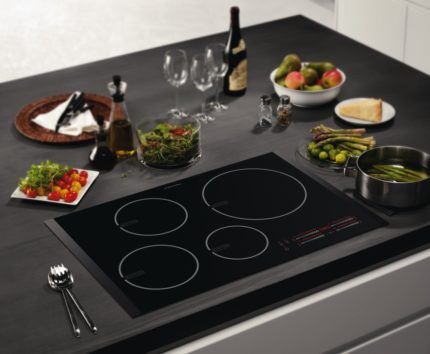
The heating technology of an induction cooker is completely different. High-frequency generators are located under the surface of the burners. They transmit eddy induction currents to the dishes, which act as a conductor.The main difference is that "induction» remains cold, heating the pans and pots placed on it.
Each heating technology has its own advantages and disadvantages. Below are the key features and distinctive features of electric and induction surfaces.
Pros and cons of an electrical panel
Today, the electric hob is installed in user kitchens more often than its competitors.
This is due to several advantages:
- Affordable price.
- Possibility of using utensils from any material.
- Absolute absence of noise during operation.
- May have glass-ceramic, metal or enamel coating. The surface is easy to maintain. Any detergent is suitable for cleaning. But, you cannot use abrasive powders.
- The heat capacity of the burners allows you to keep the finished dish warm for a long time.
- Energy efficiency modern models.
- High accuracy of the set temperature.
- There is a wide range of models on the market in different price ranges.
Among the disadvantages, users note a limitation on the maximum weight of dishes, uneven heating of the burners: in the center their temperature can reach 550 degrees, while the outer part does not exceed 180. The exception is halogen burners, which maintain an equal temperature.
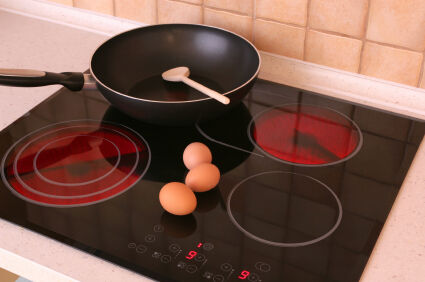
In addition, outdated models have a fairly high power consumption, and prolonged cooling of the burners can cause burns if used carelessly.
Advantages and disadvantages of induction technology
The development of technology has made it possible to reduce production costs "induction", thereby reducing its cost and market price. Manufacturers are constantly expanding the range of models and their functionality, increasing consumer demand.
High performance, compactness, energy efficiency – devices induction type correspond to these parameters.
Advantages of such household appliances:
- Minimum power consumption. It is used only to create an electromagnetic field generated in the closed conductor of the coil.
- The ability to vary the temperature with an accuracy of 1 degree.
- The operating principle allows you to achieve maximum efficiency, due to which the duration of the cooking process is reduced significantly.
- The heating process starts only when the cookware is placed on the hob and ends simultaneously with its removal. This guarantees safety of use and eliminates the possibility of burns.
- Built-in settings allow you to determine the diameter of the cookware and the desired heating area automatically.
- Large selection of programs and additional functions.
- If food and liquids get on the surface of the panel, they will not burn due to the low temperature.
- Cleaning and maintenance are the same as for electric versions. The main rule is not to use dry, powder cleaning products.
Like any technology, induction hobs have a number of disadvantages. Thus, the most significant of them are the high cost of induction panels, as well as the need to purchase special cookware with ferromagnetic properties.
An alternative option is to purchase a special adapter disk that acts as an adapter between the device and the bottom of the dish.
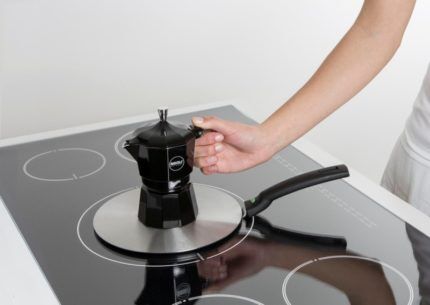
In addition, the cooling coil and fans may make subtle noise while the appliance is operating.
Recommendations for choosing equipment
The majority of models on the market require built-in placement and independent connection to the household electrical network. Even in a small-sized kitchen, a small cutting area will allow you to choose deviceequipped with a spacious work surface.
When installing, it is important to maintain a distance of at least 50 cm from refrigerator. Once you understand the technical characteristics of each type, you can make the right choice.
Electrical panel characteristics
As a heating element in electro-panels use cast iron pancakes hidden inside the structure, or rapid, hi-light and halogen burners located on enamel or steel surfaces.
It is the halogen heating elements that ensure maximum performance of the device. The optimal combination is halogen burners and a rapid spiral. This will ensure high heating speed and reduced energy consumption.
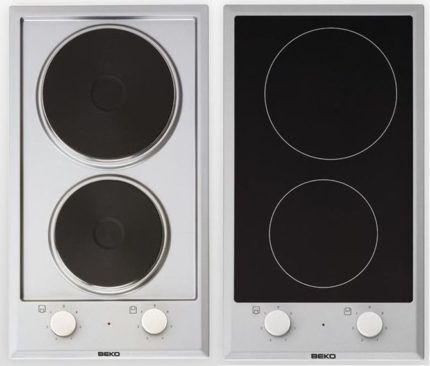
The surface of the electrical panel is made of different materials: metal, enamel, glass ceramics. The first two options are more budget-friendly and impact-resistant. They can withstand strong mechanical stress.
The advantage of glass ceramics is its visual appeal. This surface can be made in white, black and gray or beige.
Characteristics of the induction panel
The induction hob consists of glass-ceramic surface, induction coil, insulation, control unit and frequency converter.
The surface material is reliable and durable when used correctly. But it is important to remember that cermets are not able to withstand shock or excessive mechanical stress.
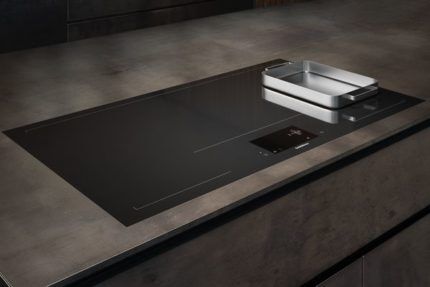
There is an opinion that induction panels have a negative impact on human health, but this is just fiction.
This has been confirmed by a number of studies:
- The electromagnetic radiation emitted is in the safe spectrum.
- At a distance of 30 cm or more from device the field is completely dissipated.
- Inductance is limited by the locality of propagation.
- Most of the energy is absorbed by the dishes placed on the panel.
But there is still one important feature: people with pacemakers should avoid using induction-type devices.
Price devices as an important selection criterion
Before purchasing household appliances, you need to compare not only the price levels of different models, but also calculate the operating costs. Induction cooktops are much newer and more modern. This affects their cost - it exceeds electric options with similar parameters.
But energy efficiency «induction» much higher, which can significantly reduce energy consumption. The other side of the issue is the availability of dishes.Purchasing new special cookware is an additional expense when purchasing an induction hob.
In addition, we suggest reading our other article, where we told you what is better - gas or electric stove.
Heating efficiency and cooking speed
Performance, along with cost, is one of the main criteria influencing the choice of household appliances. Operating principle "induction» provides high efficiency.
For example, 1 liter of water on such a panel will reach 100 degrees in 5 minutes, while this indicator on electro-surface will be equal to 10 minutes. Thus, the speed of cooking dishes using the induction version will be many times faster.
Comfort in using devices
Devices The electric type does not increase and decrease the temperature so quickly. To reduce the heat of the food being cooked, you will need to spend extra time waiting for the burner to cool down.
In this regard, the induction surface is much more convenient. It has a higher rate of temperature rise and fall.
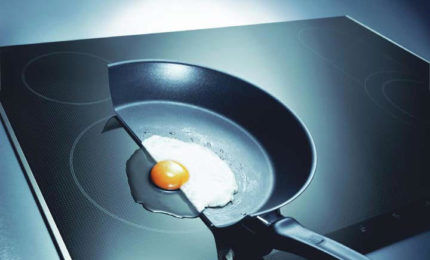
In matters of care, electric and induction panels are identical in most respects. If we compare glass-ceramic surfaces - each of them must be cleaned with gel or cream based detergents. Do not use hard sponges or powders. It is recommended to clean the panels with a soft, damp cloth.
The main difference is that before cleaning the electric version, you need to wait until it has completely cooled down.Otherwise, due to sudden temperature changes, the surface may be damaged. Work zone "induction» remains cold during cooking, so you can start cleaning it immediately after use.
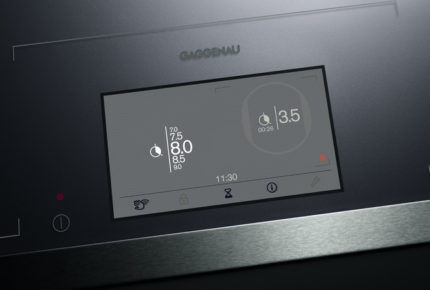
Modern models of hobs are equipped with the following functions: automatic shutdown; touch control; overheat protection; control lock and child protection.
They may also have a sensor for recognizing the area and type of cookware and a residual heat indicator.
Conclusions and useful video on the topic
Which stove to choose: induction or electric, comparison of their main characteristics:
Having weighed all the advantages and disadvantages of the devices, we can come to the conclusion that if there is no goal of maximizing cost savings when purchasing equipment, it is recommended to choose the induction option. The cost of such models is higher, but high efficiency and energy efficiency will allow you to quickly recoup your expenses.
It is worth noting that purchasing special cookware is not a problem today. Most manufacturers adapt their products for use on any hob.
If purchasing an induction panel seems too expensive, you can pay attention to modern models of electric surfaces. Many of them are as good as induction. But in this case, you need to take into account that the cost of electricity consumed will be higher.
Which hob do you prefer? Share your opinion in the comments to the material, tell us why you chose this option. You can also supplement our article by talking about those nuances of using technology that we did not mention.



